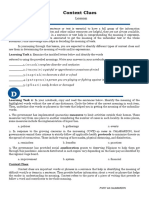0% found this document useful (0 votes)
199 views7 pagesJosh Tan Course-Notes
To understand a company's business well, focus on sales forecasts and revenue growth drivers. Look at competition and how sales may change over time. Analyze simple businesses first before more complex conglomerates. Key metrics include P/E, PEG, P/B ratios. Watch for earnings growth and price expansion. A stock can rapidly rise from earnings growth combined with increasing popularity and investor demand. Insider buying and familiarity with a company's business can indicate potential. Monitor fundsmentals regularly and be willing to sell if earnings deteriorate or opportunities elsewhere emerge stronger. Maintain a focused portfolio of up to 10 stocks to research thoroughly.
Uploaded by
Tan YongshanCopyright
© © All Rights Reserved
We take content rights seriously. If you suspect this is your content, claim it here.
Available Formats
Download as DOCX, PDF, TXT or read online on Scribd
0% found this document useful (0 votes)
199 views7 pagesJosh Tan Course-Notes
To understand a company's business well, focus on sales forecasts and revenue growth drivers. Look at competition and how sales may change over time. Analyze simple businesses first before more complex conglomerates. Key metrics include P/E, PEG, P/B ratios. Watch for earnings growth and price expansion. A stock can rapidly rise from earnings growth combined with increasing popularity and investor demand. Insider buying and familiarity with a company's business can indicate potential. Monitor fundsmentals regularly and be willing to sell if earnings deteriorate or opportunities elsewhere emerge stronger. Maintain a focused portfolio of up to 10 stocks to research thoroughly.
Uploaded by
Tan YongshanCopyright
© © All Rights Reserved
We take content rights seriously. If you suspect this is your content, claim it here.
Available Formats
Download as DOCX, PDF, TXT or read online on Scribd
/ 7






















































































